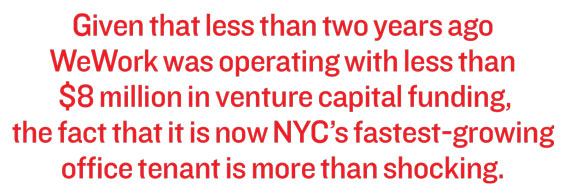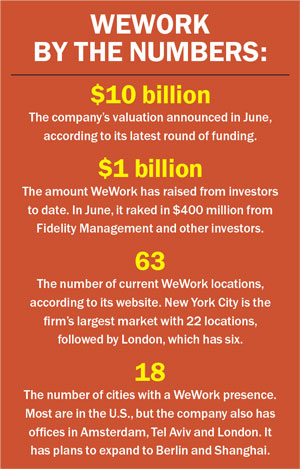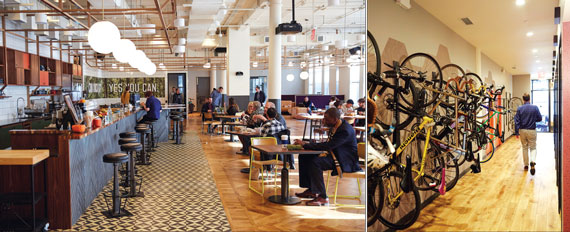Trending
The World According to WeWork
Developers and investors are quietly rushing in, spending millions to get in on the city’s next</br> real estate frontier

When WeWork’s co-founder Adam Neumann first met Forest City Ratner’s top two executives — Bruce Ratner and MaryAnne Gilmartin — four years ago, he pulled out shot glasses and poured them whiskey. The real estate execs had come to meet Neumann at WeWork’s 222 Broadway headquarters in Lower Manhattan. It was 5 p.m. on a weekday.
“[It] was a sign that this was a very different kind of company,” Gilmartin recalled at a panel hosted by the Real Estate Board of New York last month.
Since then a host of New York City’s landlords and brokers have done shots with the charismatic Israeli — either literally or figuratively.
In the short span since WeWork launched in 2010, it has turned both the shared-office industry and the office-leasing industry on its head.
The company, as the industry now knows very well, leases up office space from landlords and then sublets it out to tenants in small pieces on a short-term basis. But what’s put it on the map is that unlike the traditional co-working spaces that came before it, WeWork puts a premium on its hip communal office environment and offers a range of services, from providing healthcare to organizing social events to connecting its “members” to one another for collaboration through a private app.
Given the background of the company’s founders — Neumann grew up on a kibbutz in Israel, while co-founder Miguel McKelvey was raised in a five-mother collective in Oregon — their focus on community is not all that surprising. But given that less than two years ago they were operating with under $8 million in venture capital funding, the fact that they are now New York City’s fastest-growing office tenant is more than shocking.
This year alone, the company — which has raised $1 billion to date and has a $10 billion valuation — is on track to lease more than 1 million square feet in the Big Apple. According to a November story in the New York Times, WeWork also recently secured a $750 million credit facility from lenders including Morgan Stanley, JPMorgan Chase, Goldman Sachs and Deutsche Bank.
The company has already racked up 22 New York City locations and 63 across the globe.
But perhaps even more important than its own physical footprint is the ripple effect the firm is having on the city’s commercial industry as a whole.
 While co-working spaces have existed in New York for decades, none of them have ever garnered this kind of enthusiastic backing from the real estate industry’s elite.
While co-working spaces have existed in New York for decades, none of them have ever garnered this kind of enthusiastic backing from the real estate industry’s elite.
The company has leased space from a Who’s Who of New York City landlords, including the Durst Organization, Rudin Management, Boston Properties and Kushner Companies. That’s not to mention that Boston Properties’ founder Mort Zuckerman and Rudin CEO Bill Rudin are company investors.
David Levinson, head of L&L Holding Company and WeWork’s landlord at 222 Broadway, said he was skeptical when WeWork came to him looking to rent more than 100,000 square feet several years ago.
L&L, he said at a recent panel hosted by the Commercial Observer, did not want to take on too much financial risk and was most concerned with “protecting our bottom line.”
Before agreeing to a lease, he said, L&L requested a guarantee of credit from the startup’s investors.
“At that moment in time I would not have done a whole building deal with WeWork,” he added.
Today, the game has changed.
Catalyst for development
Not only has WeWork leased the entire office portion of several buildings, such as Rudin’s 110 Wall Street and Himmel + Meringoff’s 1460 Broadway, but it’s also serving as an anchor tenant for a major office development — Boston Properties and Rudin’s much-hyped Dock 72 at the Brooklyn Navy Yard.
And the company isn’t just filling space, it’s initiating projects. Rudin told The Real Deal that WeWork found the Dock 72 site and brought on the developers, not the other way around. That suggests that there may be other developments in its future, either in New York or elsewhere.
But just how much space can WeWork absorb before it’s maxed out?

A view of WeWork’s headquarters at 115 West 18th Street in Chelsea.
The firm’s President and COO, Artie Minson, said WeWork has the potential to grow to several hundred thousand members in New York City alone, from its current 20,000. While Rudin wouldn’t comment on specific numbers, he said WeWork “created a marketplace that continues to fill demand in the city.”
“If they keep refining and improving the product they deliver, they’ll be very, very successful,” Rudin added. “On a global basis this model has significant room to grow.”
In addition to partnering with developers and taking big blocks of space off landlords’ hands, WeWork has also already prompted some traditional office owners to rethink the way they’re designing their spaces.
Gilmartin, for one, said Forest City Ratner is designing part of the Roosevelt Island Cornell Tech Campus as a co-working space partially inspired by WeWork.
“We think that even bona fide stand-alone companies want this collision with the individual entrepreneur,” she said, speaking on the REBNY panel.
Treeline, a Brooklyn-centric office landlord, is also adapting its buildings to the WeWork age. “We are looking to upgrade our existing portfolio to permit a more open-plan, communal and collaborative space,” said Michael Schor, the firm’s chief information officer.
Meanwhile, earlier this year, Toby Moskovits, CEO of Heritage Equity Partners, told TRD that her upcoming Williamsburg office project incorporated WeWork elements.
To be sure, the spread of open floor plans predates WeWork. And major office landlords like SL Green Realty and Silverstein Properties have long offered co-working spaces in the mold of Regus, meaning more traditional and less focused on community and collaboration.
Still, landlords say WeWork’s rise has massively accelerated the co-working trend by giving it a new, hip twist and feeding off the shared-economy craze.
Paving the way
WeWork’s celebrity status has also helped lift co-working spaces from the fringe of the office market into the mainstream.
Evan Margolin, a senior vice president at Savills Studley, said the company has done a “good job of validating that industry.”
“If they’re worth $10 billion at least Wall Street sees them as an entity that will likely be around for a while,” he said. “This has paved the way for other co-working facilities to compete.”
Scott Sassoon, founder of shared-office company Blender Workspace, meanwhile, credited WeWork with making landlords far more amenable to leasing to co-working startups like his. “In the beginning when we started pitching around, no one had heard of WeWork,” he said. “Since they’ve gotten these outrageous valuations it has made it a bit easier for us.”

WeWork President Artie Minson
And landlords are increasingly happy to sign them on.
A June ranking by TRD found that the 16 biggest co-working firms occupied 4.7 million square feet of spaces at 126 locations across the city. And that number has likely only grown since.
The area surrounding Madison Square Park alone is already home to 26 co-working spaces (including two WeWorks), according to the Flatiron 23rd Street Partnership.
Not everyone, however, is sold on co-working spaces. Empire State Realty Trust’s Anthony Malkin said in June that his company “won’t lease to WeWork” and is shying away from tenants that depend on part-time workers and freelancers. “When these companies grow up, they’ll want a real building and a real landlord,” he added.
While Malkin is right that WeWork isn’t technically a landlord, it acts like one towards its members and, in some sense, competes with landlords for tenants.
But the company doesn’t just provide hip office space with beer kegs and snacks, through its partners it also offers its members healthcare, legal, banking and human resources services, to name just a few.
“What we want to be is, in addition to helping people with all the utility-like functions, to offer all the business solutions in a box — so to speak,” said Minson, who’s the former CFO of TimeWarner Cable. Neumann, a serial entrepreneur, and McKelvey, an interior architect by trade, declined multiple requests by TRD for an interview. But McKelvey put it this way in a statement: “Our intent from the beginning was to support founders and people running small businesses in as many ways as we can — from the practical and tactical to the social and emotional. In that context, offering services like healthcare, payment processing, HR and legal fit right alongside our community events, educational efforts and parties.”
Offering more services through partners, the firm hopes, will make it more attractive to potential customers and help it win more market share. (Some services, such as healthcare, stay available to members even after they leave WeWork.)
This expanded offering raises the bar for rival co-working companies. It is also forcing traditional landlords to rethink their business models. If startups become used to all the services offered in their WeWork space, will they expect the same when they grow and move on to a traditional office? And more importantly, can offering services give landlords a competitive edge when it comes to landing tenants?
 Will Silverman, a managing director at the brokerage Hodges Ward Elliott, said there are few main advantages for landlords — in addition to just pocketing more money. One is economy of scale: It’s cheaper for a landlord to hire, say, accountants and cleaners for an entire building than for each tenant to do so. This means tenants can get the services they need at a lower cost, another selling point for landlords in their tenant-wooing efforts. In addition, adding services like employee healthcare to a company’s rent bill also lowers the tenant’s payroll expenses, which in turn lowers their tax burden. “That’s a lesson that hasn’t been lost on any landlord,” Silverman said.
Will Silverman, a managing director at the brokerage Hodges Ward Elliott, said there are few main advantages for landlords — in addition to just pocketing more money. One is economy of scale: It’s cheaper for a landlord to hire, say, accountants and cleaners for an entire building than for each tenant to do so. This means tenants can get the services they need at a lower cost, another selling point for landlords in their tenant-wooing efforts. In addition, adding services like employee healthcare to a company’s rent bill also lowers the tenant’s payroll expenses, which in turn lowers their tax burden. “That’s a lesson that hasn’t been lost on any landlord,” Silverman said.
Phil Kirschner, a senior vice president at JLL’s workplace strategy team, said the trend to offer more services is also driven by large corporations like Google, whose buildings are brimming with amenities
and services.
Eventually, he argued, this trend will spill over to landlords. “It will take a little to longer to get to landlords, because they have to see value in a whole building full of small tenants.”
While it may seem far-fetched, some say New York landlords could go from being mere space providers to all-around service companies, albeit in the distant future.
And no one is arguing that all landlords will become WeWork-type service providers.
“Is everybody going to provide health insurance? Big companies have that already, so that would be redundant,” Rudin said. “It depends on the building and the tenancy.”
For her part, Leslie Himmel, managing partner at Himmel + Meringoff, called WeWork a “trendsetter,” but said “they are not changing my business model one bit.”
Treeline’s Schor is also skeptical. For one, REITs, which are some of the city’s biggest landlords, could face higher taxes if they make service income.
And for all the advantages of offering more services, there is also the danger that landlords overexpose themselves and lose track of what they do best: provide office space.
“Why doesn’t the landlord go into the burrito business? Because Chipotle does it better,” Blender’s Sassoon said.
The perils of growth
When WeWork embarked on its breakneck expansion across NYC, it needed janitors to keep its spaces clean. Like many other startups, it hired subcontractors. That decision caused the company a fair bit of trouble, to say the least.
In June, the mega union 32BJ SEIU began picketing outside WeWork’s 222 Broadway location on behalf of the Commercial Building Maintenance employees that WeWork had farmed its janitorial work out to.
The union’s campaign — which demanded higher wages and the right to unionize for the employees — depicted WeWork as a heartless capitalist with little concern for ordinary workers.
But rather than comply with 32BJ’s demands, WeWork pulled the plug on its contract with CBM and decided to hire cleaning workers directly onto its own payroll.
WeWork began hiring, but much to the workers’ dismay it did not hire most of its CBM employees back. That move led to another round of negative publicity.

WeWork’s headquarters in Chelsea features their trademark amenity-laden common areas, space for bike storage and an open floor plan.
In September, the company finally reached a deal with 32BJ, agreeing to help place union contractors if not at WeWork, then back in the workforce. But WeWork’s brand as a do-good company suffered considerable damage. “If that had continued, I wonder how that would have affected their core business,” said Richard Greenwald, a labor historian and dean at Brooklyn College, arguing that crossing picket lines might make WeWork’s mostly young and liberal members uncomfortable.
The episode highlights a bigger problem: To expand at its current pace and still offer a slate of services, WeWork needs dozens of partners and contractors. Ensuring quality (and workers’ rights) with all of them is a challenge. In addition, critics worry the company is growing too quickly.
“I do think some of the growth has to be looked at with a cautious eye because how much can you absorb?” said Tim Callahan, founder of real estate fund manager Callahan Capital Properties, at the REBNY panel. And WeWork is indeed locking itself into long-term leases at what many consider peak-market rates.
While its members pay premium rates — one WeWork member estimates he pays about $200 per square foot at the 79 Madison Avenue location, where office asking rents are in the low $40s — they are only committed on a month-to-month basis. This could cause trouble if the real estate market or the economy starts slipping. Minson, who was hired in part to help WeWork scale up even more quickly, acknowledged that the speed of growth creates challenges. But he called them “good challenges.”
“Any business would love to experience the growth we’re experiencing,” he said. “We used to open one building a month; last month we opened approximately 10 locations.”
He also noted that the firm is now better able to cope with rapid expansion. And he dismissed the suggestion that WeWork might not be able to survive a market downturn, pointing out that tech startups only make up about 20 percent of WeWork members. “If you price our product versus the competitor, our prices are meaningfully cheaper,” Minson said. “The question you have to ask yourself is where do you think these people will otherwise go if they were to leave?”
Whether WeWork succeeds or fails no longer just concerns its employees and investors. For some, it offers a model of the landlord of the future. For others, it’s another overvalued startup buoyed by the sharing-economy hype. Either way, it’s grabbing the attention of the entire real estate industry.
“I will tell you,” Gilmartin said at the REBNY panel, “that I think anybody who discounts or ignores or doesn’t learn from the co-working phenomenon is doing it at their peril.”




